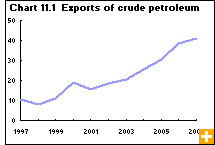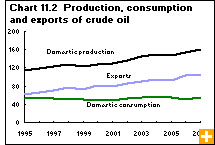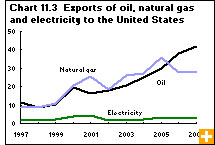Common menu bar links
Energy
Archived Content
Information identified as archived is provided for reference, research or recordkeeping purposes. It is not subject to the Government of Canada Web Standards and has not been altered or updated since it was archived. Please contact us to request a format other than those available.
Canada ranks among the world’s largest producers of energy, is energy self-sufficient and is the largest source of U.S. energy imports. Almost all of Canada’s energy exports go to the United States: the two countries trade oil, natural gas, coal and electricity. Our trade surplus in energy—crude oil, refined petroleum and other products, natural gas, coal and electricity—reached $55.9 billion in 2007, almost a 29% increase from 2004.
Oil brings billions to Canada’s economy each year. In 2007, the energy industry accounted for 5.6% of the gross domestic product and for nearly 20%, or $90 billion, of the total value of Canadian exports. That year, the industry directly employed 372,200 people, or 2.2% of the labour force.
Exports of crude oil alone reached $41.8 billion, up from $25.6 billion in 2004, and nearly four times the value a decade earlier. Exports of crude accounted for 9.3% of total merchandise trade in 2007, more than twice the proportion in 1995 (3.7%).
The volume of gasoline sales rose 3.9% from 2006 to 2007, despite the higher prices at the pump. Canadian drivers consumed 42.5 billion litres of gasoline in 2007, up 21.3% from 35.1 billion litres in 1995. Forty percent of Canadians’ energy appetite is fuelled by refined petroleum products; that proportion has basically not changed since 1990.
Crude oil production rising
In 2007, Canada produced 160.5 million cubic metres of crude oil, up 4.2% from 2006. That amounts to 2.8 million barrels per day. (One cubic metre contains 1,000 litres and equals 6.3 barrels.)
Alberta produced just over two-thirds of the crude oil pumped in 2007. Saskatchewan, a distant second, contributed 16%, while Nova Scotia’s and Newfoundland and Labrador’s offshore rigs together accounted for nearly 14%. Crude oil flows from wells in seven Canadian provinces.
Discoveries of conventional oil and gas have fallen in recent years, so the industry has increasingly been shifting to non-conventional sites—for example, offshore and the oil sands—to meet demand. In particular, higher oil prices and robust global demand have fuelled an expansion of Alberta’s oil sands industry.
Investment in the oil sands reached $18 billion in 2007, up 17% from 2006. Just a decade ago, investment by the industry was less than one-tenth that of the manufacturing sector. In 2008, producers intend to invest $19.7 billion in the oil sands alone, which will surpass the $19.6 billion planned by the entire manufacturing sector.
The oil sands are a large resource: the deposits contain as much as 27.4 billion cubic metres of economically viable oil, or enough to meet the country’s current energy needs for 500 years.
Two-thirds of production is exported
Canada exported an average of 294,411 cubic metres of crude oil per day in 2007. Since 1995, the United States has received 99% of Canada’s oil exports.
Alberta is Canada’s top energy-exporting province. All of its oil exports go to the United States, facilitated by a network of more than 16,000 kilometres of pipeline. The major beneficiary has been the U.S. Midwest. In 2007, 61.7 million cubic metres of crude oil flowed into states such as Illinois, Minnesota and Oklahoma.
Demand for Canadian crude has been growing in the RockyMountain region, which includes Wyoming, Colorado and Utah. This region imported 19.7 million cubic metres of Canadian crude oil in 2007, more than double 1995 totals.
U.S. demand driving oil production increases
From 1995 to 2007, Canada’s output of crude oil increased an average of 3.4% annually. Stronger foreign demand—almost exclusively from the United States—has been the driver; domestic demand for Canadian crude has remained fairly stable. In volume terms, Canada’s oil exports have grown an average 5.6% annually since 1995.
In 2007, Canada exported 104.8 million cubic metres to the United States, more than did Saudi Arabia, Venezuela and Mexico; our exports covered 10% of America’s oil needs.
Some oil stays in Canada
Canadian demand for crude oil reached 106,960 million cubic metres in 2007. Canada has 19 refineries with a total capacity of 324,500 cubic metres a day, according to the National Energy Board; 16 of these refineries produce a full range of refined petroleum products.
In 2006, these refineries operated at an average 90% of capacity. In 2007, 60% of Ontario’s crude oil came from Western Canada, 3% from Eastern Canada and 36% from import sources. Refineries in Western Canada process Western Canadian production exclusively, including crude from the oil sands.
More electricity flowing south and north
Canada and the United States have an extensive electricity trade, and the two countries’ electricity networks are heavily integrated, which became apparent during the Northeast blackout in August 2003. Net electricity exports to the United States in 2007 were nearly double the five-year average of 15.7 terawatt hours, generating $3.1 billion in revenue. Electricity imports from the United States more than tripled from 1995 to 2006, but they make up a small portion of Canada’s demand.
Warmer weather, making for less need for heating in the cooler months, and the shrinking manufacturing sector, have curbed electricity generation from primary sources—hydro, steam, nuclear, combustion turbines, wind and tidal. Generation from these sources slipped 0.6% in 2006 from the year before, to 444,299.9 gigawatt hours. From 1995 to 2006, generation from primary sources rose 4.5%.
Nuclear generation increased 6.4% in 2006 from 2005, as Ontario’s Pickering station returned Unit 1 to service. Nuclear power supplies 52% of the electricity generated in Ontario, enough to supply all the homes in the province. Nuclear power supplied 16% of Canada’s total electricity production in 2006.
Although Canada’s utilities are managing to meet domestic demand for electricity, new or upgraded electricity transmission facilities are being planned to serve Canada’s growing population and economy.
Electricity from wind, solar and tidal sources continues to grow, but these make up less than 0.5% of the electricity generated. Wind generation projects doubled capacity from 2005 to 2006, to 1,460 megawatts; Ontario added 400 megawatts of that. According to the Canadian Wind Energy Association, Canada ranked twelfth in the world in wind energy capacity at the end of 2006.





